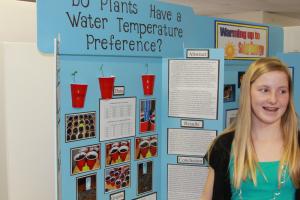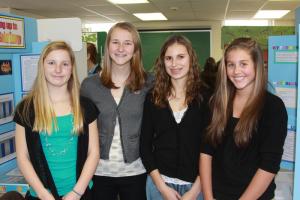The 2010 BP oil spill was on the mind of a Sussex Academy of Arts and Science eighth- grader as she decided to study oil absorbing products for her project in this year's Sussex County Science Fair.
Isabel Carulli, 14, tested natural and synthetic products to see which absorbed oil the best.
"I checked to see if what they're using is the most effective," Isabel said.
Through her experiment, she tested polypropylene fabric normally used in booms to clean up oil spills and its natural counterpart: sawdust.
The manmade fabric outperformed sawdust for absorbency. Sawdust simply added another level of cleanup to an already messy situation, she said.
Isabel was one of 98 students competing March 5 at the Biden Center in Cape Henlopen State Park. For 20 years, Sussex County science students have researched, prepared, proved and presented hundreds of projects for the Sussex County Science Fair.
This year's crop of students chose contemporary topics suited for today's world.
Beacon Middle School eighth-grader Mason Newsham used a consumer science approach to compare eggs from free-range chickens to those produced in commercial operations.
"Free-range chickens get to eat more of a variety of food such as bugs and grass instead of commercial chicken feed," he said. "This makes the eggshells from free-range chickens harder."
Besides, he added, they taste better. With 20 free-range chickens at his farm, Mason said, free-range eggs are the only kind he eats.
But Mason's project didn't stop with consumer science.
He used an engineering approach to determine which end of the egg is the strongest.
"The top half of the egg is the strongest," he said, referring to the pointier end.
Applying this concept to bridge construction, he said, bridges with higher arches are the strongest.
Beacon eighth-grader Mozella Matthews, 13, said she worked on her medicine and health project throughout the school year, comparing heart rates among subjects of varied ages. She asked her relatives – ages 7, 9, 11 and 13 – to dance, and then she recorded their heart rates.
"One thing I learned was the younger kids' heart rate can go over 200 beats a minute, and they can still be healthy," Mozella said.
This was Mozella's first year competing in the science fair, and she said it was a great experience.
"It was fun," she said. "The judges came around and asked questions, and you had to tell them what you did and explain your conclusion."
Middle school students in seventh and eighth grades joined high school students from grades nine through 12. Beacon Middle School, Sussex Academy of Arts and Sciences and high schools from Cape Henlopen, Indian River, Sussex Central and Sussex Tech sent students to participated in this year's event, judged by panel of judges from across the state.
Event coordinator and former Cape Henlopen High School science teacher Rob Schroeder said a group of educators have run the event for the past decade. He credits their dedication with the fair's success.
"This was huge for us to reach the 20th year," he said. "It's a challenge to keep doing this all these years and we were thrilled with the response.
Schroeder said 100 projects is a manageable amount and 120 entries would be the maximum they could handle.
This year's showing was ideal, he said, although he would like to see more schools attend next year.
The science fair could be considered an original science, technology, engineering and mathematics program, nowadays referred to as STEM.
Cape Henlopen and other school districts are using STEM education to help motivate students to pursue careers in STEM related fields.
Melissa Steele is a staff writer covering the state Legislature, government and police. Her newspaper career spans more than 30 years and includes working for the Delaware State News, Burlington County Times, The News Journal, Dover Post and Milford Beacon before coming to the Cape Gazette in 2012. Her work has received numerous awards, most notably a Pulitzer Prize-adjudicated investigative piece, and a runner-up for the MDDC James S. Keat Freedom of Information Award.























































